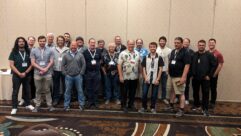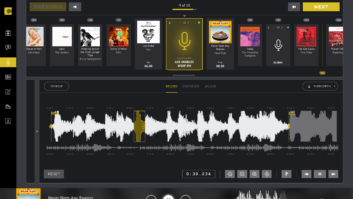In a discussion of compliance in these pages a year ago, we addressed our industry’s regulatory complexity. Readers asked us to expand on this. Most of the requests addressed radio station transmitter control systems.
In basic terms, remote control systems are viewed as attended or unattended.
(click thumbnail)Conceptual diagram of the ins and outs of a remote control system – here, a Burk ARC Plus. (Courtesy Burk Technology) Attended control systems are operator-supervised. They are described as semi-automated (the system does some of the work) or not automated at all (you make all decisions). Control points are fixed. Other than the main studio and the transmitter, you have to notify the commission where they are.
Fully automated, unattended transmission systems are, under normal conditions, monitored, adjusted and status-reported by their supervisory controller, typically a computer. No human involvement is called for moment to moment, other than a log for EAS operations and a chronology log of when the station is radiating.
In one of those “Catch 22” situations for which the federal government is so legendary, you can legally operate your station in completely automated unattended mode without any automation control equipment at all, with the following stipulations:

- One, the system has to be stable such that it meets all parameters for legal operating limits reliably. At the present state of the art (and as recognized by the commission), broadcast transmission systems when properly designed and installed are stable and reliable, the reason we can run unattended;
- Two, you have to have “control” of the system such that you can turn off the transmitter if needed;
- Three, you are not exempted from EAS compliance, legal IDs, main studio requirement, public file, local telephone number, management presence etc. These are separate issues not related to remote control;
- Four, you must have a plan (best be written to CYA) and implement that plan to maintain technical compliance. It is wise that your plan include items like making and keeping a record of periodic system checks, an annotated responsible person (such as a contract engineer), organized copies of required equipment testing and proofs, etc.;
- Five, you’d best be compliant if you are ever inspected.
Simple yet reliable
An example of a simple installation: One of my clients has a Class A FM. Its solid-state transmitter has sat exactly at 100 percent output 24/7 for 10 years now. If the main exciter breaks lock – it never has, but if it does – it toggles automatically to the backup. Radiation is controlled by the STL squelch.
On the complicated side of the ledger, another client has 64 channels of telemetry, status and control in their unattended, automated control system. The system does a great job of maintaining parameters and will page every technocrat associated with the station if there is an out-of-tolerance situation. Beyond assuring legal operation, the system will page the HVAC company if the building temperature gets too high or the LP folks if the generator fuel gets low.
From a regulatory standpoint, your station has little to gain by not running unattended. Regulatory complexity, the manpower distraction and complications of operations are less onerous. Having less paperwork, in the present inspection climate, translates into fewer potential Notices of Apparent Liability.
However, the trick is in achieving the correct functionality of that unattended, automatic system for compliance purposes and for your station’s unique circumstances.
Many manufacturers make remote control systems that are up to the task. Personal taste and the best match to your individual station needs usually motivate the choice of system. Best for our purposes is to address generally the functional and regulatory issues and some integration solutions.
Minimize failures
Because the system is programmed for the unique needs of your station, special instructions usually are kept in the microcomputer’s memory. Protect that memory with appropriate surge protectors; and control electrical noise in the power that supports your system.
Probably the best investment for your remote control system is a dedicated, high-end UPS with at least a few hours of run time. The uninterruptible power supply also will provide site information during power failures, whether expected (such as utility work) or unexpected (your generator fails to start).
The UPS also will keep the clock running. The clock’s accuracy is critical when the remote control changes powers and/or antenna modes on a time basis.
Do not forget to put surge suppression on the phone line as well.
Glitches, box failures and inadvertent keystrokes can disrupt the system’s programming. Keep a complete and accurate hard copy of the programming required to keep your system functional. You’ll need that data often – usually at the worst possible moment.
Do not let anyone make an industry out of programming your remote system or let them place your station in jeopardy by not supplying you with a copy of the programming data or keeping it current. Without this data, you’ll have to start from scratch every time problems erupt. And they will.
Change entry codes at least every year; whenever you acquire a station; and immediately if anything “funny” happens involving the remote control system.
Avoid “cute” station-related pass codes. Recently I noted a remote control phone number on a wall telco punchdown; just for curiosity I called the system on my cell. Upon entering the station frequency, I was into that system. I had control! Dumb to be that simple.
Monitor and control
What should you monitor and control?
Foremost, you have to be able to turn off the transmitter.
One way of turning it off could be simply to shut off the STL transmitter. The squelch relay contacts should activate a timer so that, a minute or two later, the timer turns off the transmitter. This avoids carrier bounce if the squelch stutters.
As noted, if your system is stable enough in critical parameters, strictly speaking you do not need automatic correction in place. However, most modern remote control equipment has tremendous capability; it can regulate output power, turn off HDAM at sundown, even turn on backup air conditioning if the building gets too hot. Why not use it?
Most folks elect to use a POTS line to access transmitter controls. One of the clearest directives from the FCC is that if the remote control system is accessed by telephone for control, a dedicated phone line must be connected to it.
This POTS line can be the only phone in the transmitter building, and you can use the phone when you’re in the building for other purposes (like ordering a pizza) because you are then in local command. Otherwise, however, the verdict is that each remote control system box has its own POTS line, and no other non-station personnel or device can use it even to order a pizza.
Problems in your transmission system can be divided into two universes: those that affect other stations and those that affect only yours. Loss of automatic frequency control (AFC) in your FM exciter with the station walking up the dial onto other station channels is an example of the former. A drop below 90 percent output from a slow output tube failure is an example of the latter.
Roughly speaking, you have three minutes to correct the first, three hours to correct the second.
For AM stations, daypart change in output power or antenna configuration requires immediate correction. For this category of fault, set up your system to respond automatically.
Most modern exciters use a reference oscillator and AFC to set the output frequency. When AFC lock is lost, most exciters issue an error signal (many use this to mute output as well). A simple logic circuit to bring on the standby exciter (assumed to be on frequency) is an automatic solution that takes seconds.
Required tower lighting is a little more complicated, as both the FCC and the FAA have an oar in the water on this one. In far northern winter locations, the tower lights will come on and go off all day long during overcast weather. However, the requirement to check the lights is only for nighttime periods.
Might I suggest this simple automatic differentiating system: Enable your alarms with a sensor that will activate when the outside light falls below 5 foot-candle. Such a change normally occurs within the 20-minute time window after darkness falls, during which you must check your tower lights by rule.
With a light failure status input, most remote control systems can be programmed to start notifying the appropriate personnel; those station folks can notify the FAA and get the repairs scheduled.
By the way, please do not wire any voltage higher than 24 volts through your control systems. Those little relays usually can’t handle the fault current and none of us like the shock when we unexpectedly encounter these lethal voltage.
Let us know your tips and questions about compliance. If readers are interested, we can explore specific programming (alarm windows, action sequences, etc.) and related circuits (if and when needed) in a future article to address the requirements we’ve covered.
Comment on this or any article to [email protected].












